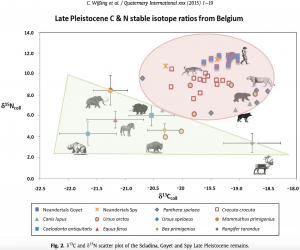01 Oct Stable isotope analyses
Stable isotope analyses (C, N, O and Sr) have been for a relatively long time used in geochemistry, geochronology and geology. The Strontium isotopes ratio (87Sr/86Sr) is used in geology for example for a dating of sea sediments and intrusive igneous rocks. The Oxygen isotopes ratio is used for palaeoecological reconstruction of temperatures in geological past. For example, OIS (Oxygen Isotope Stages) were defined o a base of the Oxygen isotopes ratio obtained from the drill cores in the Greenland ice sheet.
These methods were later used also in medicine and in anthropology for a determination of a nourishment quality of contemporaneous societies and since 1970s also for the diagnosis of stress or diseases. Massive usage of these methods in anthropology dates back about twenty years ago (Smrčka, 2005) and in archaeology about six years ago.
Strontium isotopes
Strontium isotopes enter the biosphere and the food chain during the rock erosion. From water the isotopes get into the roots and leaves of plants and later also into the vein system of herbivores and later also carnivores. In bones the Strontium binds to PO4 instead of the Calcium (Ca 2+). According to the Zinc and Strontium ratio, a nourishment of an analysed individual can be estimated. Herbivores have more Strontium and less Zinc and vice versa in a case of the carnivores. 87Sr/86Sr ratio depends on the geological background. According to the isotope composition in bones and teeth of humans and animals, the migrations of an analysed individual during his life can be detected.
Oxygen isotopes
18O/16O ratio informs us about a climate during a life of an analysed individual and about water, which it drunk. 18O isotope binds easily to Ca3(PO4)2 in bones and to Ca5(PO4)3F in tooth enamel. According to the Oxygen isotope ratio it is possible to estimate climate and also migrations during an early life of an analysed individual.
Nitrogen isotopes
According to the 15N/14N ratio it is possible to estimate, if the analysed individual was starving or not. Nitrogen isotopes can tell us also something about a diet. The highest amount of the Nitrogen isotopes is present in meat, the lowest in cereals. Lentils are also quite rich in a Nitrogen isotopes content.
Carbon isotopes
Carbon isotope analysis can tell us something about a diet. Plants can be divided into so called C4 and C3 plants. These two plant categories bind 13C and 12C isotopes to polysaccharides in a different ratio. In a case of C3 plants, 13C isotope is represented in between 22 and 30 per mile. In a case of C4 plants it is just in between 9 and 16 per mile. C3 plants are represented for example by trees or rice, C4 plants are all cereals and grasses. According to the Carbon isotopes ratio, we can estimate a nourishment of an analysed individual.
Sulphur isotopes
According to the 32S/34S ratio, diet and migrations of an analysed individual can be estimated. Specific ratio of these isotopes reflects a geological background and microbiological activities in soil and water. High amount of 34S reflects diet rich in sea food.
In the ERCA Centre, the isotope analyses and their interpretation are guaranteed by RNDr. Miriam Nývltová Fišáková, PhD. The actual analyses are conducted in respected foreign laboratories. For a precise interpretation it is always better to conduct as many isotope analyses as possible.
References:
Smrčka, V. (2005): Trace elements in Bone Tissue. Karolinum, Praha

Results of the Carbon and Nitrogen stable isotope analyses in the Neanderthal teeth and Upper Pleistocene animal teeth from the Scladina, Govet and Spy caves in Belgium. Source: Wikipedia Commons.





